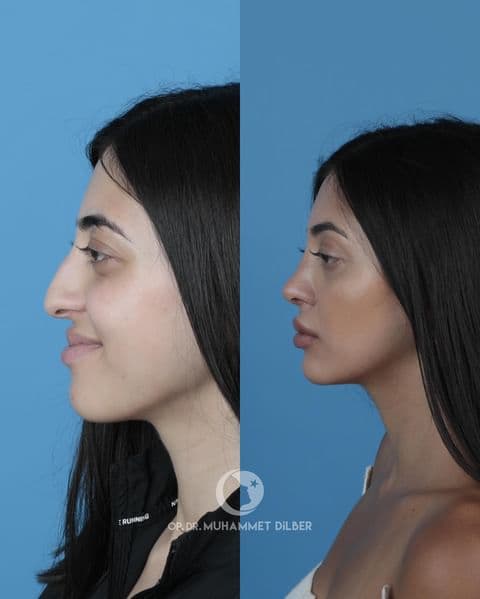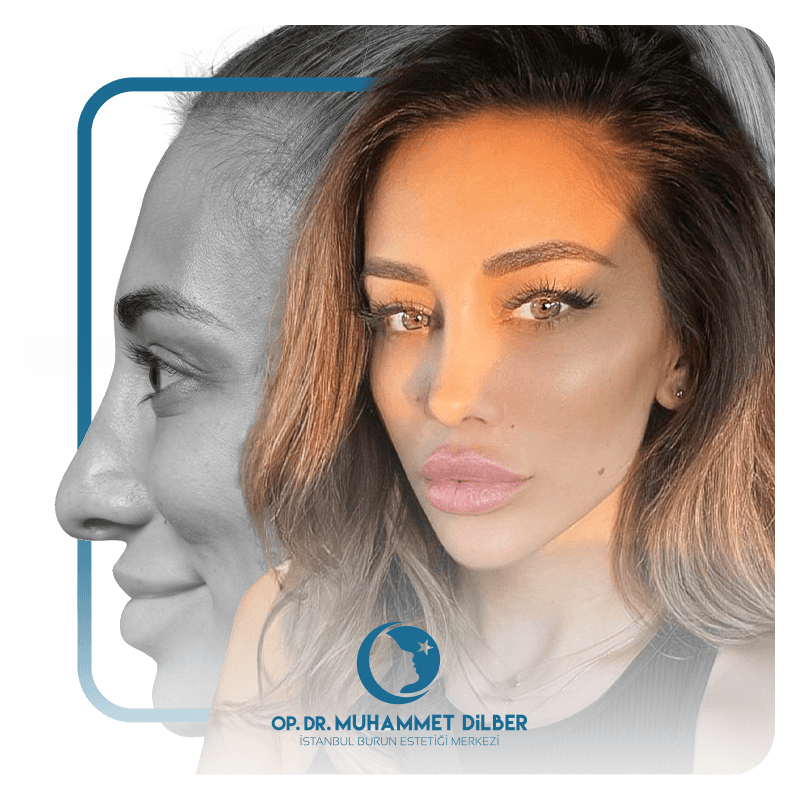
Revision (secondary) rhinoplasty

What is Revision Rhinoplasty?
20/12/2023
Revision rhinoplasty, also referred to as corrective nasal surgery, is a procedure designed to address unsatisfactory outcomes resulting from a previous rhinoplasty operation. There is some debate regarding the terminology, with some defining revision rhinoplasty as subsequent procedures performed by the same surgeon to rectify issues from the initial operation. In contrast, secondary rhinoplasty is commonly used to describe corrective nasal aesthetic surgery performed for the second or subsequent times, irrespective of the original surgeon.
Unfortunately, not every rhinoplasty procedure yields satisfactory results. Issues such as a broad or pinched tip, asymmetry, droopiness, excessively short or raised nose (pig nose), and uneven nostrils may arise. Problems like alar collapse (nasal sidewalls collapsing) can impede breathing, while a persistent nasal hump or bridge collapse may still be present. The nose may exhibit a parrot’s beak appearance (Polly-beak) due to insufficient cartilage removal or a saddle nose due to excessive cartilage removal. Other concerns include an inverted V appearance, a twisted nose, ongoing deviation, irregularities on the nasal bridge, and the development of excessive scar tissue inside and outside the nose.
In fact, the aesthetic and functional complications stemming from primary rhinoplasty contribute to the potential issues addressed in revision rhinoplasty.
Unfortunately, 7-15% of primary rhinoplasty cases necessitate secondary (revision) rhinoplasty. Some cases involve minor revisions where small adjustments suffice because the initial results are generally acceptable. Patients may be content with the overall look and feel of their current nose but seek minor refinements. Conversely, major corrective revision surgery is required when the previous rhinoplasty has led to noticeable shape deformities. Unsuccessful rhinoplasty can significantly impact a patient’s self-confidence, deterring them from social activities. Such patients are often discontent with their noses and apprehensive about undergoing revision surgery, grappling with concerns about potential failure or worsening outcomes and questioning their trust in the surgeon.
Unfortunately, not every rhinoplasty procedure yields satisfactory results. Issues such as a broad or pinched tip, asymmetry, droopiness, excessively short or raised nose (pig nose), and uneven nostrils may arise. Problems like alar collapse (nasal sidewalls collapsing) can impede breathing, while a persistent nasal hump or bridge collapse may still be present. The nose may exhibit a parrot’s beak appearance (Polly-beak) due to insufficient cartilage removal or a saddle nose due to excessive cartilage removal. Other concerns include an inverted V appearance, a twisted nose, ongoing deviation, irregularities on the nasal bridge, and the development of excessive scar tissue inside and outside the nose.
In fact, the aesthetic and functional complications stemming from primary rhinoplasty contribute to the potential issues addressed in revision rhinoplasty.
Unfortunately, 7-15% of primary rhinoplasty cases necessitate secondary (revision) rhinoplasty. Some cases involve minor revisions where small adjustments suffice because the initial results are generally acceptable. Patients may be content with the overall look and feel of their current nose but seek minor refinements. Conversely, major corrective revision surgery is required when the previous rhinoplasty has led to noticeable shape deformities. Unsuccessful rhinoplasty can significantly impact a patient’s self-confidence, deterring them from social activities. Such patients are often discontent with their noses and apprehensive about undergoing revision surgery, grappling with concerns about potential failure or worsening outcomes and questioning their trust in the surgeon.

How to do Revision rhinoplasty?
Revision rhinoplasty, known as corrective nasal surgery, offers two approaches—open and closed—similar to primary rhinoplasty. It's essential to clarify that these approaches are not distinct surgical techniques but rather methods employed to access the nose's cartilage and bone structures.
In the open approach, also termed the External approach, a small inverted V or W-shaped incision is made on the columella (the structure dividing the nostrils), allowing the surgeon to lift the skin and access the underlying structures. The incision is discreetly closed at the conclusion of the procedure. Conversely, in the closed approach, all incisions are confined within the nasal passages. The choice between open and closed approaches depends on the specific interventions needed and the most effective execution. The closed approach offers benefits such as no disruption to nasal tip support mechanisms, reduced trauma, accelerated healing, reduced postoperative edema, and absence of postoperative numbness on the nasal tip. For noses with asymmetry or requiring major revisions, particularly in half lip rhinoplasty, I prefer the open approach due to its comprehensive access to the entire nose's cartilage and bone structures, facilitating diverse graft and suture techniques.
Revision surgery differs from primary surgery in that tissues may have constricted, valuable cartilage and bone tissues may have been excessively or asymmetrically removed, and weakened cartilages may have twisted. This necessitates more delicate and meticulous work during the operation. Skin and soft tissues play a pivotal role in revision rhinoplasty, often housing scar tissue. Compared to primary rhinoplasty, there is typically more pronounced tissue inflammation in revision cases. In patients with thin skin, protruding structures must be meticulously addressed, grafts appropriately thinned, and if necessary, enveloped in fascia. For those with thick skin, sturdy cartilage is essential to stabilize the nasal tip and withstand the weight of the nose skin, with swelling requiring a longer resolution period, sometimes up to two years. The operation duration varies from 30 minutes to 4 hours, contingent on the nose's shape and the approach applied. While minor adjustments may be completed in 30 minutes, major revisions could extend to 3-4 hours. Grafts are frequently employed in revision rhinoplasty, and depending on the case, cartilage from the nasal septum, ears, or rib (costal) cartilage may be utilized, extending the operation time. Nonetheless, emphasis should be on achieving optimal results rather than the operation's duration.
The success of revision rhinoplasty rests on well-developed judgment, competence, knowledge, and, above all, experience. Surgeons must possess significant anatomical knowledge and stay abreast of surgical approaches. Moreover, they should be prepared to address unexpected challenges. Postoperative follow-up is indispensable and should span an extended period. In my rhinoplasty philosophy, I aspire to be both the inaugural and concluding surgeon performing the operation. Correspondingly, in revision rhinoplasty, my aim is to ensure the patient's contentment and be the ultimate surgeon involved. The postoperative process mirrors that of primary rhinoplasty.
Where do you procure the Cartilage from when needed in a Revision Rhinoplasty?
Grafts serve as essential structural components in the process of nose reshaping. My primary choice, when feasible without compromising nasal support, is to utilize cartilage from the septum. If this option is not viable, I turn to cartilage from the ear. In cases where additional support is needed, especially in major revisions, I resort to rib cartilage obtained from the patient.
In primary rhinoplasty, cartilage from the septum typically fulfills the grafting requirements. However, in revision rhinoplasty, ear or rib cartilage is often necessary, depending on the extent of deformities and the prior use of septal cartilage in previous surgeries.
The removal of cartilage from the nose septum is possible, leaving behind a 1.5cm L-shaped support. I prefer septal cartilage primarily because it is readily available in the operative field, eliminating the need for extra incisions. Additionally, septal cartilage is easily moldable, provides structural support, and retains its shape. Nevertheless, the often inadequate amount of remaining cartilage after previous septal usage in revision rhinoplasty necessitates alternative sources.
When obtaining cartilage from the ear, incisions may be made to the front or back of the ear, strategically placed within the ear folds to be inconspicuous after healing. The removal of cartilage only from the pit ensures that there is no alteration in the ear's shape, and there is no impact on hearing. Depending on the requirements, grafts may be obtained from both ears.
Ribcage cartilage is sourced from the area where the 7th rib meets the chest bone. Accessing the rib cartilage involves a 2-3cm incision, and the necessary cartilage size is then extracted.
This strategic approach ensures that the choice of graft material is tailored to each patient's unique needs, optimizing both functional and aesthetic outcomes in rhinoplasty procedures.
Revision rhinoplasty, known as corrective nasal surgery, offers two approaches—open and closed—similar to primary rhinoplasty. It's essential to clarify that these approaches are not distinct surgical techniques but rather methods employed to access the nose's cartilage and bone structures.
In the open approach, also termed the External approach, a small inverted V or W-shaped incision is made on the columella (the structure dividing the nostrils), allowing the surgeon to lift the skin and access the underlying structures. The incision is discreetly closed at the conclusion of the procedure. Conversely, in the closed approach, all incisions are confined within the nasal passages. The choice between open and closed approaches depends on the specific interventions needed and the most effective execution. The closed approach offers benefits such as no disruption to nasal tip support mechanisms, reduced trauma, accelerated healing, reduced postoperative edema, and absence of postoperative numbness on the nasal tip. For noses with asymmetry or requiring major revisions, particularly in half lip rhinoplasty, I prefer the open approach due to its comprehensive access to the entire nose's cartilage and bone structures, facilitating diverse graft and suture techniques.
Revision surgery differs from primary surgery in that tissues may have constricted, valuable cartilage and bone tissues may have been excessively or asymmetrically removed, and weakened cartilages may have twisted. This necessitates more delicate and meticulous work during the operation. Skin and soft tissues play a pivotal role in revision rhinoplasty, often housing scar tissue. Compared to primary rhinoplasty, there is typically more pronounced tissue inflammation in revision cases. In patients with thin skin, protruding structures must be meticulously addressed, grafts appropriately thinned, and if necessary, enveloped in fascia. For those with thick skin, sturdy cartilage is essential to stabilize the nasal tip and withstand the weight of the nose skin, with swelling requiring a longer resolution period, sometimes up to two years. The operation duration varies from 30 minutes to 4 hours, contingent on the nose's shape and the approach applied. While minor adjustments may be completed in 30 minutes, major revisions could extend to 3-4 hours. Grafts are frequently employed in revision rhinoplasty, and depending on the case, cartilage from the nasal septum, ears, or rib (costal) cartilage may be utilized, extending the operation time. Nonetheless, emphasis should be on achieving optimal results rather than the operation's duration.
The success of revision rhinoplasty rests on well-developed judgment, competence, knowledge, and, above all, experience. Surgeons must possess significant anatomical knowledge and stay abreast of surgical approaches. Moreover, they should be prepared to address unexpected challenges. Postoperative follow-up is indispensable and should span an extended period. In my rhinoplasty philosophy, I aspire to be both the inaugural and concluding surgeon performing the operation. Correspondingly, in revision rhinoplasty, my aim is to ensure the patient's contentment and be the ultimate surgeon involved. The postoperative process mirrors that of primary rhinoplasty.
Where do you procure the Cartilage from when needed in a Revision Rhinoplasty?
Grafts serve as essential structural components in the process of nose reshaping. My primary choice, when feasible without compromising nasal support, is to utilize cartilage from the septum. If this option is not viable, I turn to cartilage from the ear. In cases where additional support is needed, especially in major revisions, I resort to rib cartilage obtained from the patient.
In primary rhinoplasty, cartilage from the septum typically fulfills the grafting requirements. However, in revision rhinoplasty, ear or rib cartilage is often necessary, depending on the extent of deformities and the prior use of septal cartilage in previous surgeries.
The removal of cartilage from the nose septum is possible, leaving behind a 1.5cm L-shaped support. I prefer septal cartilage primarily because it is readily available in the operative field, eliminating the need for extra incisions. Additionally, septal cartilage is easily moldable, provides structural support, and retains its shape. Nevertheless, the often inadequate amount of remaining cartilage after previous septal usage in revision rhinoplasty necessitates alternative sources.
When obtaining cartilage from the ear, incisions may be made to the front or back of the ear, strategically placed within the ear folds to be inconspicuous after healing. The removal of cartilage only from the pit ensures that there is no alteration in the ear's shape, and there is no impact on hearing. Depending on the requirements, grafts may be obtained from both ears.
Ribcage cartilage is sourced from the area where the 7th rib meets the chest bone. Accessing the rib cartilage involves a 2-3cm incision, and the necessary cartilage size is then extracted.
This strategic approach ensures that the choice of graft material is tailored to each patient's unique needs, optimizing both functional and aesthetic outcomes in rhinoplasty procedures.
